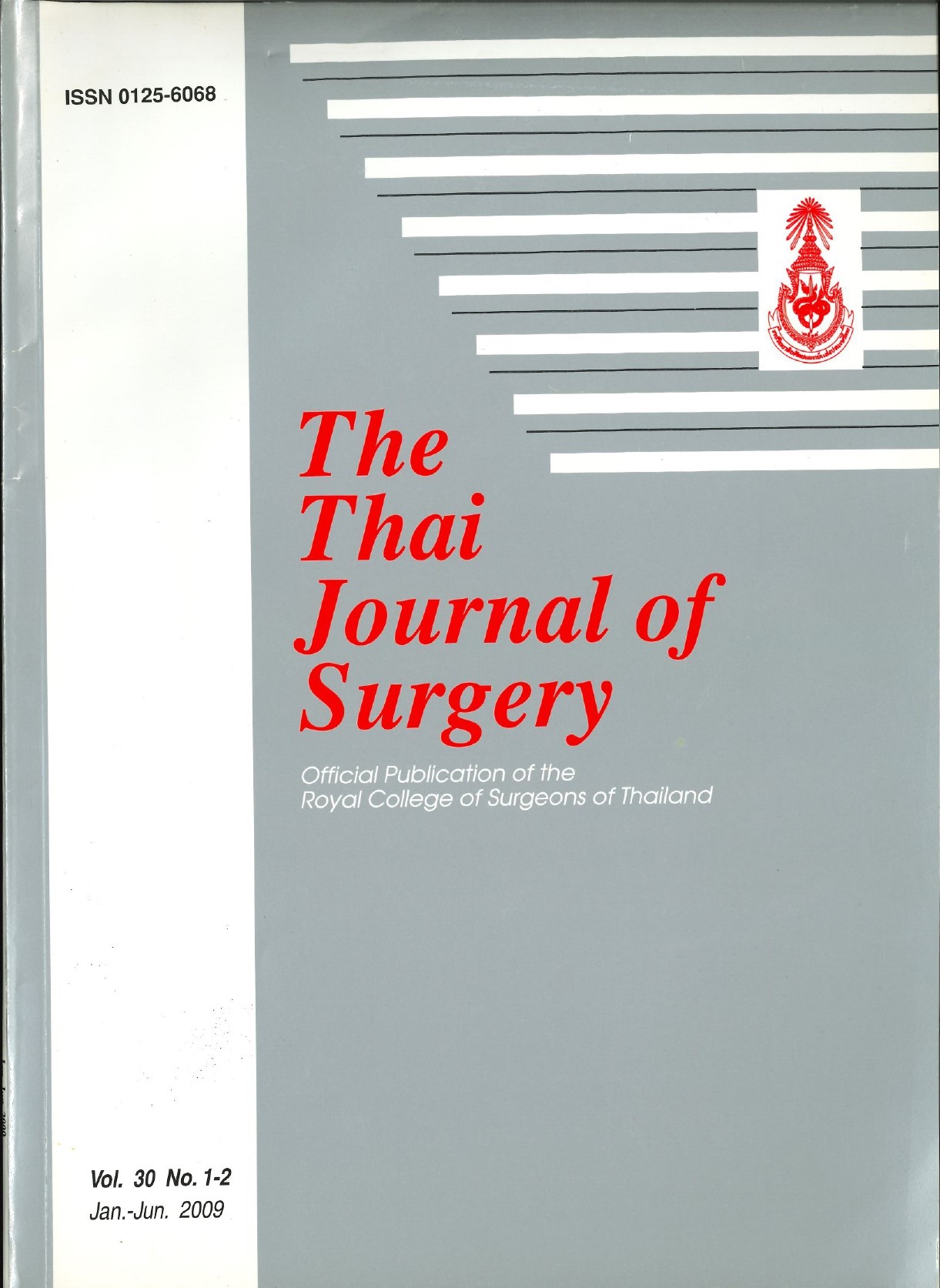Leading Points in Infancy and Childhood Intussusception
Keywords:
Intussusception, pathologic leading points, hydrostatic barium enema reduction, pneumatic reduction, intestinal polyps, Meckel’s diverticulumAbstract
Background: The etiology of most intussusception is idiopathic. However, some cases may have leadingpoints.
Objectives: The purpose of this study is to analyze and discuss the cases of intussusception in children
with pathologic leading points. Materials and Methods: A retrospective review of medical records of the patients who were treated at
the Queen Sirikit National Institute of Child Health, formerly Children’s Hospital, for intussusception during
the 19-year period between January 1988 and December 2006 was carried out.
Results: There had been 1,025 episodes of intussusception in 956 children with 37 patients having
leading points. The incidence of intussusception with leading points was 3.8%. Twenty three were males and
14 were females. The average age was 45 months (ranging from 14 days to 12 years). Barium enema study was
done in 16 patients. Hydrostatic barium enema reduction was attempted in 12 patients and two cases were
successfully reduced. Pneumatic reduction was used in 11 patients with 13 episodes and two had successful
reduction. The non-operative reduction was not attempted in 12 patients due to poor condition or unavailability
of non-operative reduction. All of the 37 patients underwent laparotomy except one case using colonoscopy and
polypectomy. Intestinal polyps and Meckel’s diverticulum were the most common leading points and found in
14 cases each. Duplication cysts and lymphoma were noted in 3, and 2 cases, respectively. The others were
tuberculosis of the intestine, ectopic pancreatic tissue and pseudotumor of the colon. All of the leading points
were resected and the postoperative courses were uneventful.
Conclusions: Children with intussusception having leading points could be present in all age groups.
Attempted non-operative reductions were not successful in most cases. Surgical resection should be done in all
of the cases when the leading point was seen.
References
1975;10:751-4.
2. Ein SH. Leading points in childhood intussusception. J
Pediatr Surg1976;11:209-11.
3. Ein SH, Alton D, Palder SB. Intussusception in the 1990s: has
25 years made difference ? Pediatr Surg Int 1977;12:374-6.
4. Ein SH, Shandling B,Reilly BJ, Stringer DA. Hydrostatic reduction
of intussusception caused by lead points. J Pediatr Surg
1986;21:883-6.
5. Ein SH, Stephens CA. Intussusception: 354 cases in 10 years.
J Pediatr Surg 1971;6:16.1-3.
6. Ein SH, Stephens CA, Shandling B, Filler RM. Intussusception
due to lymphoma. J Pediatr Surg 1986;21:786-8.
7. Daneman A, Alton DJ, Lobo E, Gravett J, Kim P, Ein SH.
Pattern of recurrent intussusception in children: a 17- year
review. Pediatr Radiol 1998;28:913 - 7.
8. Daneman A, Myers M, Shuckett B, Altan DJ. Sonographic
appearances of inverted Meckel diverticulum with
intussusception : a 17-year review. Pediatr Radiol 1997;27:295-
9.
9. Navorro O, Daneman A. Intussusception Part 3: diagnosis
and management of those with an Identifiable or
predisposing cause and those that reduce spontaneously.
Pediatr Radiol 2004;34:305-12.
10. Navorro O, Dugougeat F, Kornecki A, Shuckett B, Alton DJ,
Daneman A. The impact of imaging in the management of
the intussusceptions owing to pathologic lead points in
children: a review of 43 cases. Pediatr Radiol 2000;30:594-
9.
11. Blakelock RT, Beasley SW. The clinical implication of nonidiopathic
intussusception. Pediatr Surg Int 1998;14:163-7.
12. Turner D, Rickwood AMK, Brereton J. Intussusception in older
children. Arch Dis Child 1980;55:544-6.
13. Ein SH, Daneman A. Intussusception. In: Grosfeld JL, O’Neill
JA Jr, Fonkalsrud EW, Coran AG, editors. Pediatric surgery.
6th ed. St Louis: Mosby, 2006:1313-41.
14. Hu SC, Feeney M, McNicholas M, O’Halpin D, Fitz.Gerald RJ.
Ultrasonography to diagnose and exclude intussusception
in Henoch-Schonlein purpura. Arch Dis Child 1991;66:1065-
9.
15. Stringer MD,Pablot SM,Brereton RJ. Pediatric intussusception.
Br J Surg 1992;79:867-71.
16. Ong NT, Beasley SW. The lead point in intussusception. J
Pediatr Surg 1990;25:640-3.
17. Young DG. Intussusception. In: O’Neill JA Jr, Rowe MI,
Grosfeld JL, Fonkalsrud EW, Coran AG, editors. Pediatric
surgery. 5th ed. St Louis: Mosby, 1998:1185-95.
18. Doberneck RC, Deane WM, Antoine JE. Ectopic gastric
mucosa in the ileum: a cause of intussusception. J Pediatr
Surg 1976;11:99-100.
Downloads
Published
How to Cite
Issue
Section
License
Articles must be contributed solely to The Thai Journal of Surgery and when published become the property of the Royal College of Surgeons of Thailand. The Royal College of Surgeons of Thailand reserves copyright on all published materials and such materials may not be reproduced in any form without the written permission.



